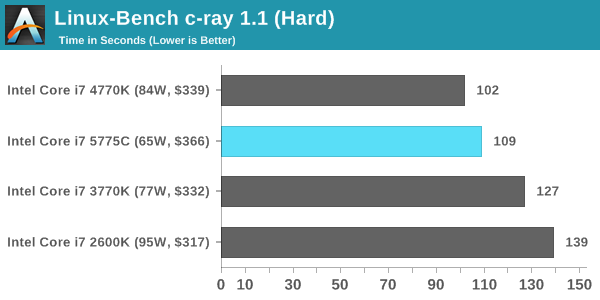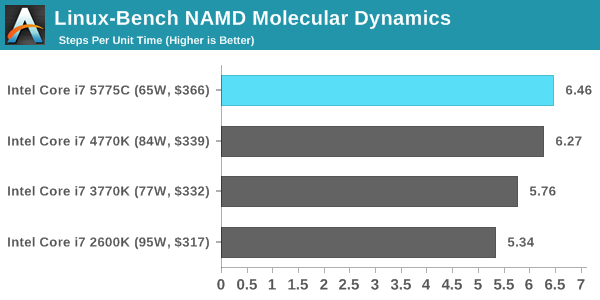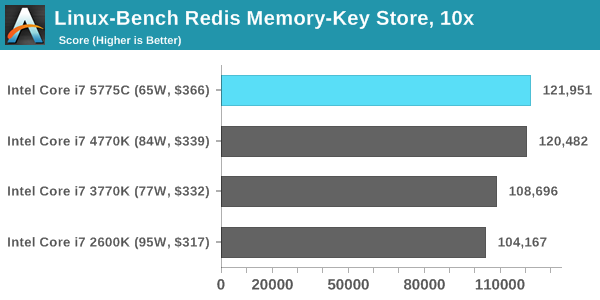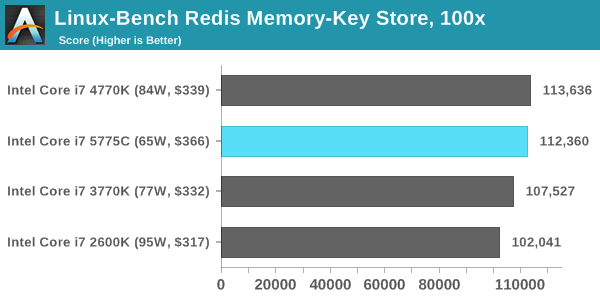The Intel Broadwell Review Part 2: Overclocking, IPC and Generational Analysis
by Ian Cutress on August 3, 2015 8:00 AM ESTLinux Performance
Built around several freely available benchmarks for Linux, Linux-Bench is a project spearheaded by Patrick at ServeTheHome to streamline about a dozen of these tests in a single neat package run via a set of three commands using an Ubuntu 11.04 LiveCD. These tests include fluid dynamics used by NASA, ray-tracing, OpenSSL, molecular modeling, and a scalable data structure server for web deployments. We run Linux-Bench and have chosen to report a select few of the tests that rely on CPU and DRAM speed.
C-Ray: link
C-Ray is a simple ray-tracing program that focuses almost exclusively on processor performance rather than DRAM access. The test in Linux-Bench renders a heavy complex scene offering a large scalable scenario.

NAMD, Scalable Molecular Dynamics: link
Developed by the Theoretical and Computational Biophysics Group at the University of Illinois at Urbana-Champaign, NAMD is a set of parallel molecular dynamics codes for extreme parallelization up to and beyond 200,000 cores. The reference paper detailing NAMD has over 4000 citations, and our testing runs a small simulation where the calculation steps per unit time is the output vector.

NPB, Fluid Dynamics: link
Aside from LINPACK, there are many other ways to benchmark supercomputers in terms of how effective they are for various types of mathematical processes. The NAS Parallel Benchmarks (NPB) are a set of small programs originally designed for NASA to test their supercomputers in terms of fluid dynamics simulations, useful for airflow reactions and design.

Redis: link
Many of the online applications rely on key-value caches and data structure servers to operate. Redis is an open-source, scalable web technology with a b developer base, but also relies heavily on memory bandwidth as well as CPU performance.













121 Comments
View All Comments
plonk420 - Wednesday, August 12, 2015 - link
you "blame" AMD?a fuckup warrants "blame." you can't really "blame" someone or some company for not being smart enough to outwit/outperform the competition.
david_tocker - Tuesday, August 4, 2015 - link
I recently upgraded my i7-920 to a Xeon x5670 in the same board. Less power, more performance, same motherboard. Has USB3 - what else do I need?StevoLincolnite - Monday, August 3, 2015 - link
Same situation as you.Got a 3930K... It has happily sat at 4.8ghz just fine for many many years and still gives Haswell-E a good run for it's money. Only paid $500 AUD at the time too!
That is in stark contrast to the 5930K which is currently $860 AUD... Intel has provided me with ZERO compelling reason to upgrade unless I wish to drop down $1500 for the 5960X, which isn't three times as fast as my 3930K.
It's like they don't want my money!
If Intel had released an 8-core 5930K around the $600 mark I wouldn't have thought twice about upgrading, even if the motherboard and memory drove the prices higher.
Also still got a Core 2 Quad Q6600 rig running at 3.6ghz which handles most tasks fine, it's almost 8 years old now, it has certainly paid for itself and still handles most of the latest games fine.
Flunk - Monday, August 3, 2015 - link
I totally agree with you, 6-cores isn't worth bothering with for what Intel's charging. I'm still holding on to my i5-2500k, which does 4.4 all day at 1.2V (and a bit more if you give it a bit more juice).Jetpil0t - Thursday, August 6, 2015 - link
Haven't even bothered to take my 2500k past 4.0 Ghz leaving all the tuning at stock, I remember back in the day I had er up at 4.6 stable with tweaks, but even then it wasn't really a bottleneck. Humming along at 55c max under load @ 4.0Ghz. Most of these CPUs are much hotter thanks to the IGP as well, making Sandy even more enjoyable. Also why would a K series CPU even ship with integrated graphics in the first place.Samus - Monday, August 3, 2015 - link
I still rock a Asus X58 with a i7-950 (used to be a i7-920) back at the office. Never overclocked, completely stable, still completely competitive with modern PC's 7 years later.Obviously it uses more power (130w vs 80w) to a comparably performance-equivalent Haswell Xeon 1230v3 but the difference is a few dollars a year,
hughlle - Monday, August 3, 2015 - link
And I still rock a tock Q6600 and HD 7750. Plays everything that's on the market just fine :)Jon Tseng - Tuesday, August 4, 2015 - link
yeah I still have QX6850 and GTX 970 and it runs all new gaming releases ultra @1080p smooth as butter.I have a suspicion I'm going to get a decade of use out of this Kentsfield, which is completely nuts (and bad news for Intel!)
Bad Bimr - Monday, August 3, 2015 - link
Same here. I have an Asus x58 motherboard with 24GB CL7 memory. Recently pulled the 4Ghz overclocked i7-920 and replaced it with an $85 Xeon X5675 overclocked to 4.6Ghz. My ancient system will hold it's own against most newer systems. Not going to upgrade until Skylake-E or later.xorfish - Monday, August 3, 2015 - link
Go Xeon, those 6 core chips go for 80$ and perform as well as a 4790k in multithreaded tasks.Got mine to 4.0 Ghz for 24/7.
Also 32nm saves you some power...